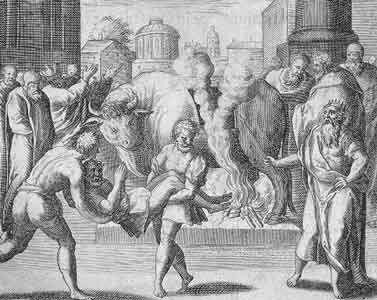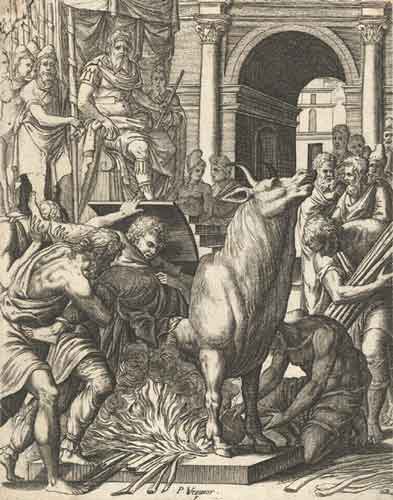.
When the people of Himera had made Phalaris military dictator, and were going to give him a bodyguard, Stesichorus wound up a long talk by telling them the fable of the horse who had a field all to himself. Presently there came a stag and began to spoil his pasturage. The horse, wishing to revenge himself on the stag, asked a man if he could help him to do so. The man said, ‘Yes, if you will let me bridle you and get on to your back with javelins in my hand’. The horse agreed, and the man mounted; but instead of getting his revenge on the stag, the horse found himself the slave of the man. ‘You too’, said Stesichorus, ‘take care lest your desire for revenge on your enemies, you meet the same fate as the horse. By making Phalaris military dictator, you have already let yourselves be bridled. If you let him get on to your backs by giving him a bodyguard, from that moment you will be his slaves.’Aristotle , Rhetoric II
Phalaris was tyrant of Acragas (Agrigentum) in Sicily, c. 570-554 BC.
He was entrusted with the building of the temple of Zeus Atabyrius in the citadel, and took advantage of his position to make himself despot (Aristotle, Politics, v. 10). Under his rule Agrigentum seems to have attained considerable prosperity. He supplied the city with water, adorned it with fine buildings, and strengthened it with walls. On the northern coast of the island the people of Himera elected him general with absolute power, in spite of the warnings of the poet Stesichorus (Aristotle, Rhetoric, ii. 20). According to the Suda he succeeded in making himself master of the whole of the island. He was at last overthrown in a general rising headed by Telemachus, the ancestor of Theron (tyrant c. 488-472 BC), and burned in his brazen bull.

Perillus of Athens, the first victim of his invention
Phalaris has become renowned for his excessive cruelty. In his brazen bull, invented, it is said, by Perillus of Athens, the tyrant's victims were shut up and, a fire being kindled beneath, were roasted alive while their shrieks represented the bellowing of the bull. Perillus himself is said to have been the first victim.
Some scholars of the early 20th century proposed a connection between Phalaris's bull and the bull-images of Phoenician cults (cf. the Biblical golden calf), and hypothesized a continuation of Eastern human-sacrifice practices. This idea has subsequently fallen out of favor, however.
The story of the bull cannot be dismissed as pure invention. Pindar, who lived less than a century afterwards, expressly associates this instrument of torture with the name of the tyrant. There was certainly a brazen bull at Agrigentum that was carried off by the Carthaginians to Carthage, when it was again taken by Scipio and restored to Agrigentum. In later times the tradition prevailed that Phalaris was a naturally humane man and a patron of philosophy and literature. He is so described in the declamations ascribed to Lucian, and in the letters which bear his own name (but which Richard Bentley proved to have been written centuries later, possibly by Adrianus of Tyre). Plutarch too, though he takes the unfavourable view, mentions that the Sicilians referred to Phalaris' severity as "justice" and "hatred of crime."

Perillus forced into the bronze bull, Pierre Woeiriot (1531-1596)
This article incorporates text from the public domain 1911 Encyclopædia Britannica.
| Ancient Greece
Science, Technology , Medicine , Warfare, , Biographies , Life , Cities/Places/Maps , Arts , Literature , Philosophy ,Olympics, Mythology , History , Images Medieval Greece / Byzantine Empire Science, Technology, Arts, , Warfare , Literature, Biographies, Icons, History Modern Greece Cities, Islands, Regions, Fauna/Flora ,Biographies , History , Warfare, Science/Technology, Literature, Music , Arts , Film/Actors , Sport , Fashion --- |
Retrieved from "http://en.wikipedia.org"
All text is available under the terms of the GNU Free Documentation License

